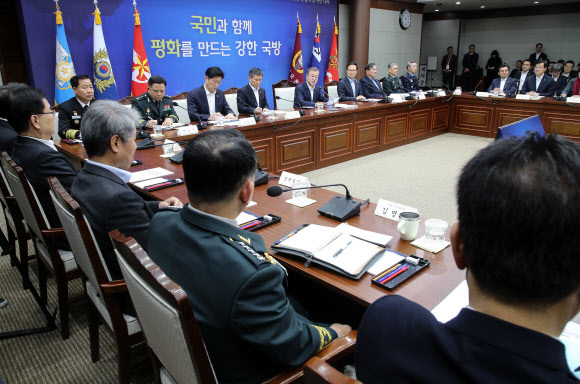 |
|
South Korean President Moon Jae-in is briefed on the Ministry of National Defense’s working plan for 2019 in Seoul on Dec. 20. (Blue House photo pool)
|
MND plans to install direct hotline between top commanders of South and North militaries
On Dec. 20, South Korea’s Ministry of National Defense (MND) briefed President Moon Jae-in on its working plan for 2019, in which it promised to faithfully implement the Comprehensive Military Agreement (CMA), concluded on Sept. 19, and lay the foundation for building military confidence in order to achieve denuclearization and to establish permanent peace on the Korean Peninsula. In effect, the MND expressed its commitment to a “national defense that makes peace,” in the words of the plan’s title. The briefing on Thursday made no mention of concepts commonly employed in previous years, such as “preparing for the threat of North Korea’s nuclear weapons and missiles” or the “three-axis system” composed of the “Kill Chain,” “Korean Air and Missile Defense (KAMD)” and “Korea Massive Punishment and Retaliation.” Following the briefing, Defense Minister Jeong Kyeong-doo said that “we are reviewing changes to the terminology of the ‘three-axis system’” while introducing the concept of “4D operations,” referring to “detect, decision, defense and destroy.” This presumably reflects a desire to avoid provocative language about launching a preemptive strike on North Korea or taking out its leadership. “We have nearly finalized the plan to hold regular meetings of the inter-Korean joint military committee once a quarter to deliberate key military issues. Our goal is to launch the committee in the first half of next year,” the MND announced on Thursday. The MND has also concluded that there are no technical difficulties with setting up a direct hotline between the supreme commanders of the South and North Korean militaries. “There are currently around 100,000 circuits available for use in the military phone lines that have been laid around the East and West Sea regions,” said an MND official. “Following the complete dismantlement of the guard posts that were part of the probationary withdrawal program in the DMZ, we will also be discussing the issue of shutting down all the guard posts,” the MND added. Speeding up transfer of OPCON to S. Korean forces The MND has decided to focus its efforts next year on a “practical assessment” of speeding up the transfer of wartime operational control (OPCON) of South Korean forces. As the first stage in that process, the MND is planning to assess initial operational capability in Aug. 2019 using a “future command structure” led by a general in the South Korean military. The verification of the OPCON transfer occurs in three assessment stages, beginning with initial operational capability and continuing with full operational capability and then full mission capability. If these assessments are carried out on a yearly basis, the OPCON transfer can likely take place within Moon Jae-in’s presidency. It was also decided that South Korea and the US’ “Foal Eagle” joint field mobility exercises, which have hitherto been carried out on a large scale every April, will be instead carried out throughout the year with a reduced number of participating troops and equipment in order to support “diplomatic efforts.” The command post exercises that are carried out on computer simulations (including the Key Resolve and Freedom Guardian exercises) will be held as usual, with one in the first half of the year and another in the second half. South Korea’s ground forces will be reorganized to make them capable of rapid and decisive operations. On Jan. 1, 2018, a ground operations command will be established, which will supervise a fires brigade consisting of multiple launch rocket systems (MLRS) and tactical surface-to-surface guided missiles. The navy will be establishing a naval demolition battalion (UDT/SEALs) under a special warfare flotilla to eliminate obstacles to amphibious operations. The air force has decided to create a satellite surveillance and control squadron and a surveillance flight squadron that operates the “global hawk” high-altitude drone and to add another squadron of F-35A fighters. The size of the standing army will be reduced from 599,000 to 579,000 next year, with the army planning to maintain the number of troops at 500,000 in 2022. By Yoo Kang-moon, senior staff writer Please direct comments or questions to [english@hani.co.kr]






